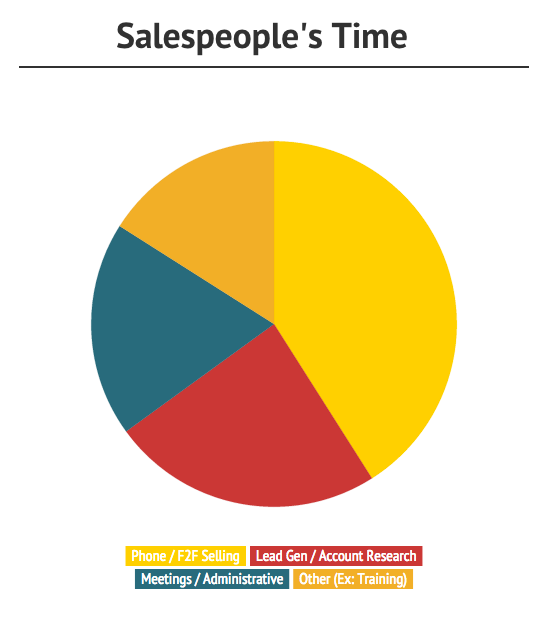Determining your sales team’s key performance indicators (KPIs) is just step one. Then comes the crucial part: Ensuring your team not only knows what those KPIs are, but how they’re performing around those indicators. And you need to ensure this as often as possible. We’re talking real-time visibility. Not quite convinced? Then you should know this:
Real-time visibility into sales KPIs lets you…
1. Stay on pace.
You’ll know whether your team’s on pace to hit quarterly sales goals at all times, so you won’t be stuck making Hail Mary passes at the end of the quarter. (This is assuming you use leading indicators for your KPIs. Read more on that here.)
2. Build future sales.
Staying on pace also lays the foundation for future sales success. Let’s say your team’s behind on the 15th of the month. They’ll probably spend the following two weeks closing, with limited time dedicated to top-of-the-funnel activities. This isn’t going to set deals up well for the coming months.
3. Increase capacity.
When you understand which KPIs make a difference and keep your salespeople focused on them, you’ll get more out of the team you already have. That means more revenue, without having to hire more salespeople or raise prices.
4. Answer: “What next?”
Your team juggles so many responsibilities. In fact, one study by CSO Insights revealed that salespeople spend: 41% of their time selling by phone or face-to-face; 24% of their time generating leads and researching accounts; 19% on meetings and administrative tasks; and 16% on other tasks, such as service calls or training. Now think about how many activities fall within each of these portions. How does your team know what to do next to get them to their goals? Give them 3-4 main sales KPIs to focus on and constant insight into how they’re performing around those KPIs, and you won’t have to worry about that.

5. Get your team engaged.
Most salespeople want to succeed, which means they’ll be happy to receive direction. Visible KPIs will not only offer it to them, but help with their engagement and potentially retention. Can you guess what the sales hiring specialists at the Rainmaker Group say is one of the top three ways to mess up a hire? Failure to set up expectations, including those around goals and performance. “‘ ‘Sell as much as you can’ is not a clear expectation,” founder Chris Young wrote on the Sales Wolf Blog. “All employees need feedback and direction – especially salespeople. The sales manager’s job is to set expectation then offer feedback and direction on the team member’s progress.”
6. Ensure busy = ROI.
Everyone’s busy. Keeping your team focused on what matters (i.e., your core sales KPIs) will make sure they stay busy on the right things.
7. Give performance insight.
How can a team member truly improve sales performance if they don’t even know which activities are most important for them to perform well on? They can’t. When your entire team focuses on just a few KPIs and has visibility into sales performance each salesperson will recognize where they stand on critical selling activities in comparison to their peers.
8. Promote collaboration.
When salespeople better understand their own challenges (as a result of knowing where their sales performance stands), many will seek out help from top-performing peers. For example, if one of your KPIs is face-to-face meetings and one salesperson can’t land any, don’t be surprised if that team member approaches a top-performer and asks for tips. Sometimes struggling team members will even seek out coaching from company leaders. In short, performance visibility leads to very organic leader-to-salesperson and peer-to-peer mentoring. [Read more on that in this free eBook on sales leaderboards.]
9. Lower the 74%.
Objective Management Group studied 700,000 salespeople over 24 years and found that 74% of salespeople are failing. Pretty dramatic number, right? The good news is this: Most of the people in the 74% can improve with training. We’ve talked about the direction and internal mentoring benefits that come with highly visible sales KPIs. Consider the impact those can have on that 74%.
10. Move the middle.
The benefits discussed above will help to boost your middle performers’ sales output, too. In most companies, 20% of the sales force supplies 80% of the revenue. What if you could raise that 20%? Give more visibility to well-developed KPIs, and you can find out.
These 10 are really just the start. Add it all up, and you’ll see that highly visible sales KPIs are one of the most powerful tools you have as a sales leader. Make this a priority starting today. Broadcast your KPIs, and performance around them, in as many places as you’re able, leveraging your CRM, sales leaderboards, emails, all-team meetings and any other channel that will keep your team informed.
Also make sure to check back with our blog for more KPI insights.




